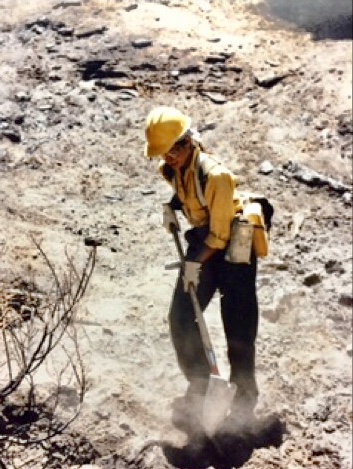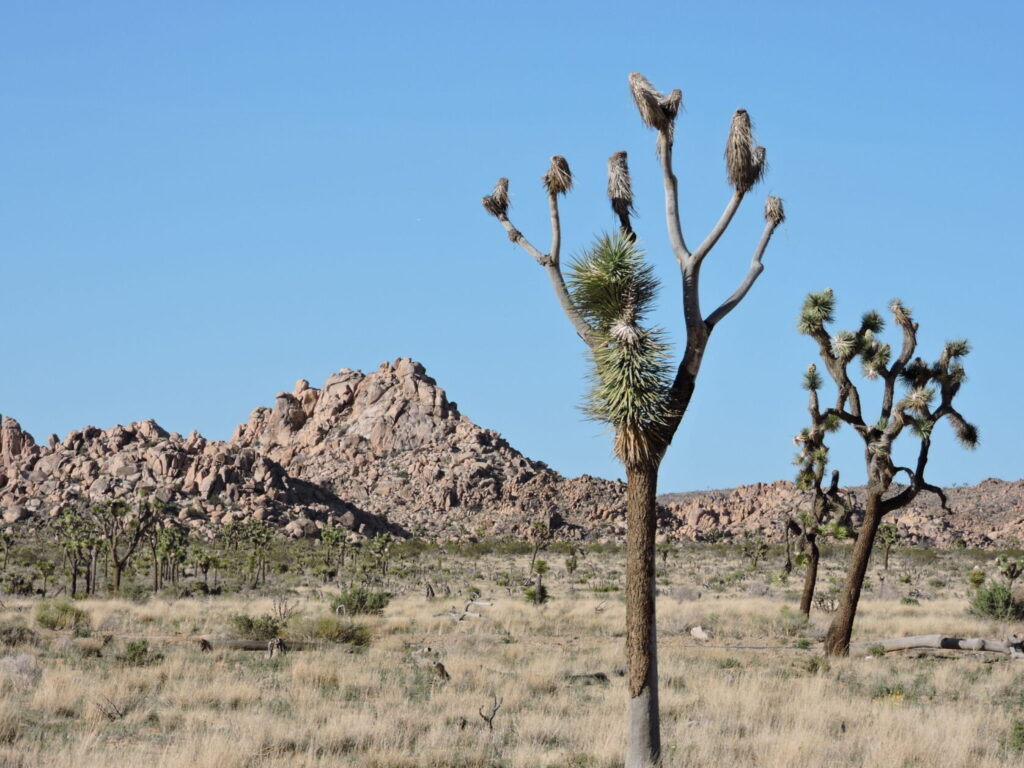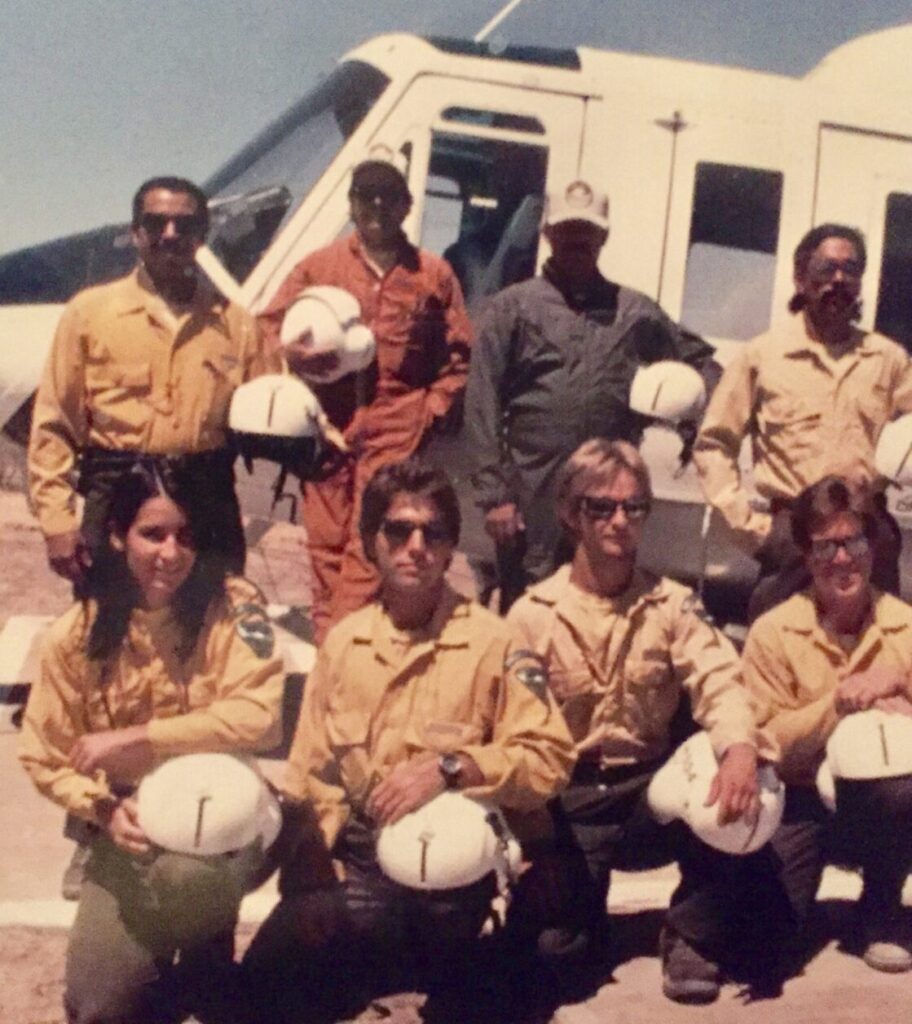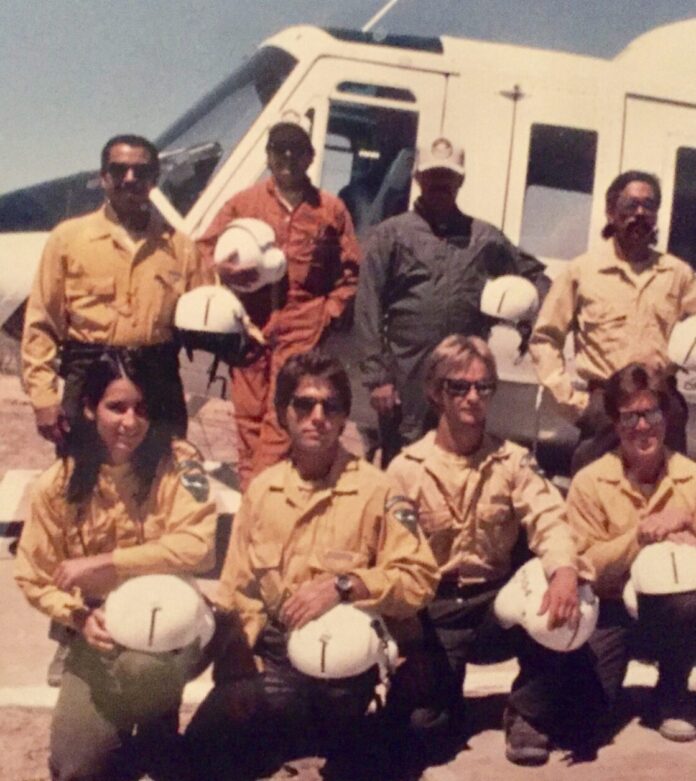Poems by a Female Firefighter
It’s the most unraveled and well-paying job I’ve had, fighting fires in far-flung, fiery wilderness areas…Most of the time, I was the only girl on the crew, cutting fireline and sucking down smoke, and after a fire had laid down…our job was far from done.
— From the poem “Mopping Up” by writer and female firefighter Ruth Nolan, excerpted from Fire and Rain: Ecopoetry of California (Lucille Lang Day and Ruth Nolan, coeditors, Scarlet Tanager Books 2018.)

For seven summer seasons during the 1980s, I worked as a seasonal wildland female firefighter, first for the Mojave Greens red-card crew out of the United States Forest Service San Bernardino National Forest, and later, for the Bureau of Land Management’s California Desert District.
Much of the time, I was one of a few, (and sometimes the only) women firefighters on these crews. The work was hot, hard, and usually in unimaginably far-flung wilderness areas across the Western United States far beyond the reach of roads and human familiarity.
We got there by foot, by fire engine, and helicopter. Typically, as one of they only women firefighters surrounded by men in these preternatural conditions far removed from cities and civilized society, I was asked things like, “What’s a nice girl like you doing out here?” and told, “You don’t belong out here.”
This rugged work gave me a close-up access to the inner workings of the fierce force of wildland fires and the many ways it has historically shaped and continues to influence the ecologies in this part of the U.S.
As a female firefighter working to put out wildfires with shovels, water and a terrible two-headed axe tool known as the Pulaski, I saw the power and destruction of the flames, and saw the inevitability of these fires as a necessity to cleanse the thick brush and forests of decades of overgrown detritus, and even began to see the role of wildfires as a fundamental part of a wider and long-established fire regime.
I never imagined, back when I fought fires as my primary financial means to help me get through my college years, that I’d now be extensively researching writing about wildfire, in my poetry and in my scholarly project, Fire on the Mojave: Stories from the Deserts and Mountains of Inland Southern California, and coediting an anthology focusing on the vastly differing, unique yet inter-related ecologies of my home state, California.
Fire and Rain: Ecopoetry of California showcases a number of poems by poets whose works investigate the devastating and continued presence of wildfire events in California’s mountains, inland hills and valleys and deserts.

Just as I continue to struggle to evoke the presence of women firefighters in the workforce of wildland firefighters – typically, media outlets representing men in media interviews and images of soot-faced men cutting through fiery brush with chainsaws, conquering the inferno’s wrath — I, along with the poets writing on this topic in the anthology, struggle through our poetic voices to evoke a feminine principle to the ravaging aspects of wildfire in our Golden State: one of inevitability, along with healing and renewal for our landscapes themselves and those who suffer untold losses from these fires.
In her poem “Fire Cycle,” poet Thea Gavin examines the landscape around her in the aftermath of the 28,000-acre Santiago Fire: “Defeated oaks / four times my age have crumpled since;/ … but if you learn to look / sweet native plants hum with juicy life:/ scarlet silene and blue erigeron are stars / in the universe of dust…” Yes, the hills of coastal Southern California are tormented by fire, but the beauty and renewal of wildflowers promise new abundance in the spring that follows the previous autumn’s fire.
California wildfires don’t occur out of nowhere: they are fueled into being by an incredibly complex relationship between geography, botany, weather and the dense presence of people in areas known as the Wilderness Urban Interface. Typically, the worst wildfires are stoked well in advance of their flames by the extreme drought conditions that precede their presence by months or even years. The severity of these droughts is now exacerbated by global warming.
In his poem “Drought,” Sierra Nevada-based poet Stephen Meadows writes: “Hot breath / on lupine / on sizzling / Sierra / parched grass / …ponderosa / brown needles / low water / sucks / the stone.” Readers can feel the suspense of the building fire dangers and almost begin to sense the arriving flames.
At best, and wisely, as these poets evoke in Fire and Rain, people living in California can think ahead and be prepared against the arrival of wildfire where they live, but wildfires are a frequent visitor and can never really be avoided.
Those who live here must learn to cohabit with wildfires and strive to coexist as safely and harmoniously as possible, as San Francisco Bay Area poet Stephanie Noble writes, in her poem, “In This Land of Wind and Tinder”: “My scoop of ice cream curled with a crown of black ash / drifted south from the forest fire fifteen miles away / … Next day at home, again a fiery red sun / to our north, Middletown burns to the ground / … And I pray for calm air and rain / in this land of wind and tinder.”

My 8” high, leather White’s Fire boots, still occupy a place in my closet, along with my fire hat, one of my fire-retardant yellow Nomex shirts and a shovel I once fought fire with during my years as a wildlands female firefighter. To some, these relics of my wildland firefighting days may look grimy, but to me they represent my hard work and now-unimaginable courage I summoned to go out to landscapes where the hearts of wildfires burn and fueled by adrenaline, hurriedly cut fire lines in dirt and sand, hoping to stave off the flames and in some cases, save our own lives.
And for me, as one of the only women firefighters and sometimes the only woman on the crews I worked on, a fascination with the cycle of how wildfire’s furies leave charred landscapes in the summer and fall, then yield explosions of wildflowers and new offshoots of chaparral and forest seedlings that follow the next spring, leave indelible impressions of awe and wonder.
Ruth Nolan, coeditor of Fire and Rain: Ecopoetry of California and a widely published writer/scholar whose work focuses on California’s deserts, is a former wildland female firefighter for the federal Bureau of Land Management’s California Desert District. A professor of creative writing at College of the Desert, Palm Desert, California, she has received a Bread Loaf Environmental Writers Fellowship and a California Writers Residency Award. She is the author of numerous books and articles, holds her MFA in creative writing from the University of California, Riverside and continues to be an inspiration to women firefighters across the U.S.





